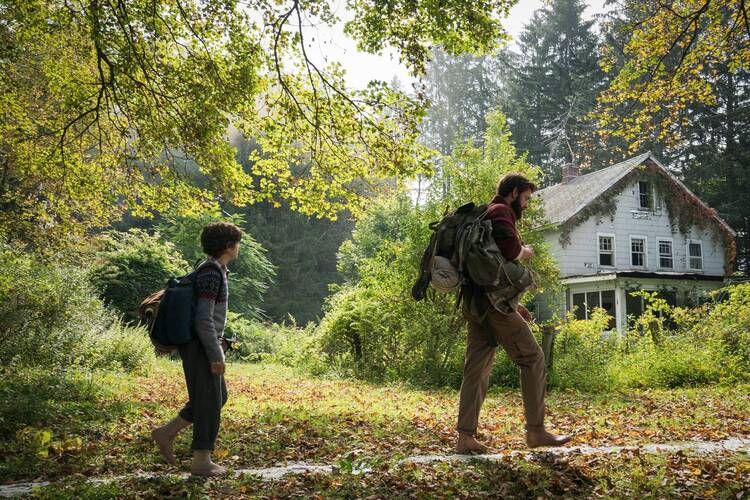John Krasinski’s compelling film “A Quiet Place” is replete with paradox. We tend to think of horror films as loud, screechy affairs, punctuated by the occasional and obvious moments of pause that precede “startle scares,” but “A Quiet Place” works against these tropes. Immense stretches of silence replace the usual aural chaos of a thriller, with composer Marco Beltrami (“Logan,” “The Hurt Locker”) laying a spare but percussive soundtrack onto the film’s spacious canvas. At times the only sounds we hear are instrumental mimicry of footsteps and heartbeats.
In modern life we associate silence with tranquility and solitude, but the quietude of the film’s central figures is grounded in fear of persecution: They are afraid precisely because they know they are not alone.
The quietude of the film’s central figures is grounded in fear of persecution.
The movie, in which Krasinski also stars, opens with a family picking through an abandoned general store. They do this noiselessly, with only the slightest hint of a footfall or the scrape of a medicine bottle across a shelf. As soon as we see the youngest member of the Abbott family, however, the precariousness of their situation becomes clear.
The boy is doing surprisingly well—until he reaches for a toy rocket on a shelf too high for him. It begins to topple, and his sister races to catch the toy before it hits the ground. The sister is deaf, and she is excellently played by Millicent Simmonds, who is herself deaf. The directorial decision to alternate between her perspective and that of her hearing family members adds an additional dimension of authenticity to the film.
We soon learn why they are being so painfully quiet—if they make any sound above a certain level, a barely-seen, blind monster will flash onto the scene and snatch its unfortunate prey away. These fleeting creatures have exquisite hearing, and so silence is crucial for survival.
As a result, the film provides an intriguing commentary on generally unexplored facets of sound and silence, particularly as to how they relate to human relationships. As Krasinski has asserted, at its heart “A Quiet Place” is a movie about family.
Anyone who has ever taken part in a silent retreat knows that it is often in silence that the mind becomes most aware of its demons. The noise and distractions that normally keep them at bay are not available, so souls on retreat have no choice but to face them unarmored, hopefully with the guidance of a skilled spiritual director.
Krasinski’s insistence on silence as a tool for survival is shared by other films, though usually in different genres. Films like “Into Great Silence” (2005) and “Why Has Bodhi-Dharma Left for the East?”(1989) illustrate the meditative value of silence; Martin Scorsese’s “Silence” (2016) provides a terrifying example of the silence required for physical survival in its depiction of the persecution of Jesuits and lay Christians in mid-seventeenth-century Japan.
However, not all sound in “A Quiet Place”is menacing. Krasinski plays with the notion of sound-as-defense in a scene in which his character, Lee, is swaying gently with his pregnant wife, Evelyn, (played by his real-life spouse, Emily Blunt), listening with her through shared earbuds to Neil Young’s “Harvest Moon.”
There are strata of sound and non-sound here—the couple determinedly projects silence to the beast that stalks them, all the while using the music to soothe and quiet their presumably terrified thoughts. In contrast to the general prohibition of technological noise at retreats, the music here is a beautiful intrusion. This family’s silence allows them to survive; the music gives them a nostalgic glimpse into how they once thrived.
The humans are quiet in this place because they have to be—but sounds still pervade the family’s lived environment. The natural world can be loud, of course, as in a scene in which the roar of a waterfall is deliberately used by father and son to obscure the sound of their voices.
Almost as if in solidarity with the family on the screen, we dare not risk provoking the wrath of the ever-lurking monsters by making a sound. This is not easy viewing; it’s not meant to be. But like many trials, it also contains moments of beauty. It terrifies, but it is also a paean to themes of sacrifice, forgiveness and even hope. As with the apparent tranquility of its verdant landscapes, there is much more beneath this film’s surface than one might expect.










